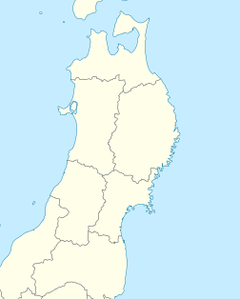Miracle Pine Tree
奇跡の一本松 | |
 | |
 Location in Tohoku, Japan | |
| Coordinates | 39°0′12.48″N 141°37′30.43″E / 39.0034667°N 141.6251194°ECoordinates: 39°0′12.48″N 141°37′30.43″E / 39.0034667°N 141.6251194°E |
|---|---|
| Location | |
| Type | Earthquake disaster monument |
| Material | Pine, Fibre-reinforced plastic, Stainless steel、Plastic and so on |
| Width | 15 m |
| Height | 27 m |
| Beginning date | September 12, 2012 [1] |
| Completion date | June 30, 2013 [2] |
| Opening date | July 3, 2013 |
| Dedicated to | Great East Japan Earthquake |
The Miracle Pine Tree (奇跡の一本松, Kiseki no Ippon matsu) is the lone surviving tree of the Takata Pine Forest, which suffered deadly damage from the Great East Japan Earthquake tsunami in 2011.[3][4][5] It is located in Rikuzentakata, Iwate Prefecture.[6][7][8] It is one of the remains (monuments) of the Great East Japan Earthquake.[9][10]
Overview[]
In the 2011 Tōhoku earthquake and tsunami, the tsunami was over 10 meters in height at Takata Pine Forest in Rikuzentakata, and almost the entire grove was completely swept away, with the exception of one lone pine tree.[11]
This lone survivor caught the public's imagination as a symbol of hope and was widely reported upon by newspapers worldwide.[12] Also, since one tree survived, the official designation as a "Place of Scenic Beauty" was not revoked. The lone surviving pine died in December 2012 due to seawater contamination of the surrounding soil. Disaster recovery work began in December 2013 with the building of a new sea wall and restoration of the beach, which had been buried in meters of silt. Cleanup efforts were hampered by fears that the wood of the fallen pines had been contaminated by radiation effects from the Fukushima Daiichi nuclear disaster. Tree planting events were held in 2017 and 2018, during which time 2500 pine seedlings were planted by volunteers. The area is now part of the Sanriku Fukkō National Park.
References[]
- ^ "「奇跡の一本松」保存業務の受注について" (Press release) (in Japanese). 株式会社乃村工藝社. 2012-09-06. Retrieved 2013-11-24.
- ^ "「奇跡の一本松」保存事業に係る工期の延長につきまして" (Press release) (in Japanese). 株式会社乃村工藝社. 2013-03-25. Retrieved 2013-11-24.
- ^ "Miracle Pine". Atlas Obscura. Retrieved 2021-08-13.
- ^ デジタル大辞泉. "奇跡の一本松とは". コトバンク (in Japanese). Retrieved 2021-08-13.
- ^ "3.11 忘れない FNN東日本大震災アーカイブ". 2019-03-01. Archived from the original on 2019-03-01. Retrieved 2021-08-13.
- ^ "Miracle Pine". Visit Miyagi. Retrieved 2021-08-13.
- ^ "Tohoku's Miracle Pine: The Recovery of Rikuzentakata". Tokyo Weekender. 2019-09-05. Retrieved 2021-08-13.
- ^ "奇跡の一本松|陸前高田市ホームページ". www.city.rikuzentakata.iwate.jp (in Japanese). Retrieved 2021-08-13.
- ^ "奇跡の一本松と高田松原|復興の軌跡|NHK災害アーカイブス". NHK災害アーカイブス. Retrieved 2021-08-13.
- ^ "高田旅ナビ | 陸前高田市観光物産協会公式サイト". 高田旅ナビ | 陸前高田市観光物産協会公式サイト (in Japanese). Retrieved 2021-08-13.
- ^ Toru Asami (18 April 2011). "Battle to protect sole surviving pine tree". Asahi Shimbun. Retrieved 10 February 2012.
- ^ Demetriou, Danielle (5 December 2011). "Sole surviving pine tree and symbol of Japan's post-tsunami hope is dying". The Daily Telegraph. Retrieved 10 February 2012.
See also[]
- 2011 Tōhoku earthquake and tsunami
- Individual pine trees
- Rikuzentakata, Iwate

